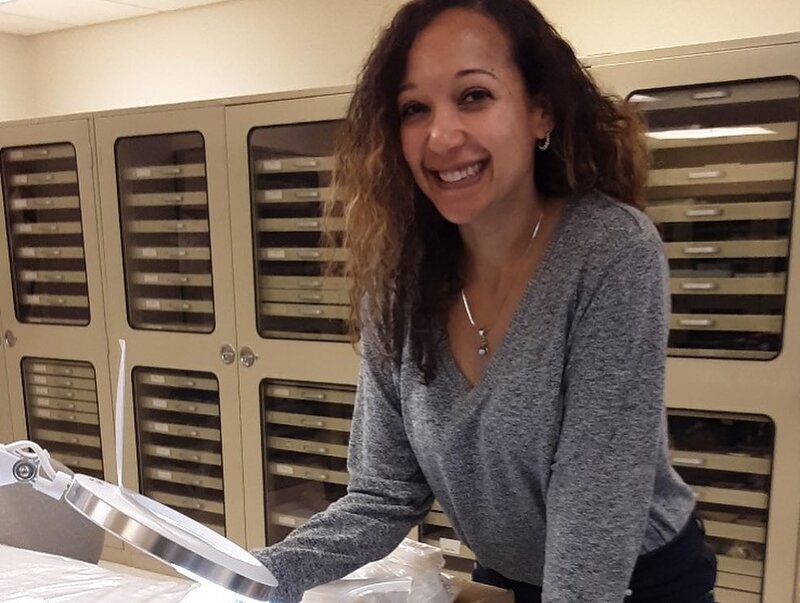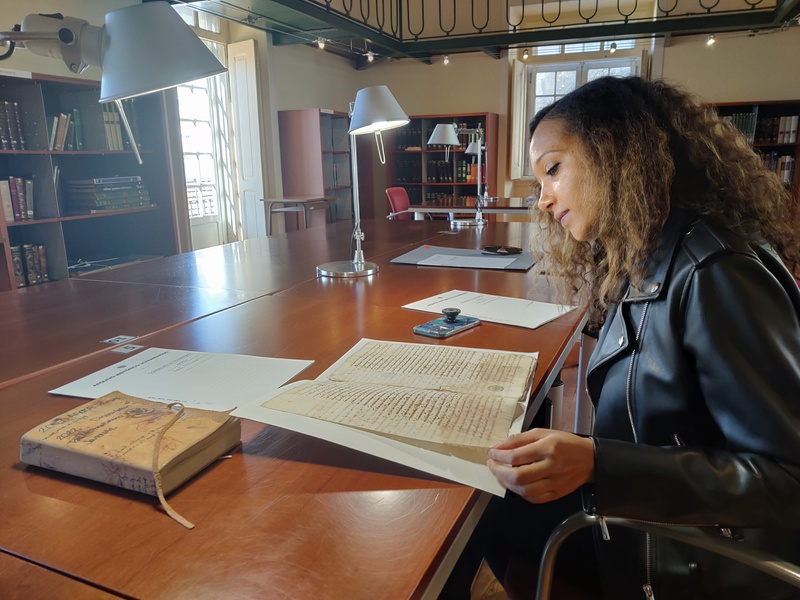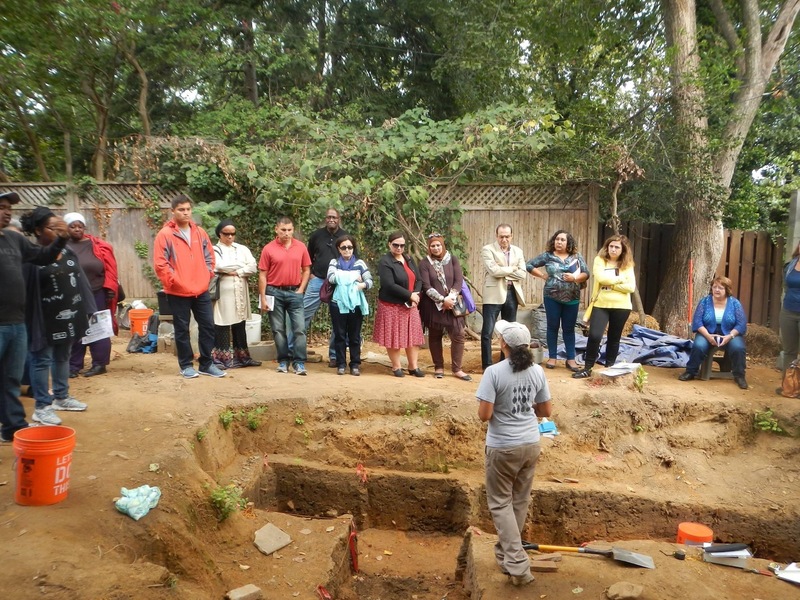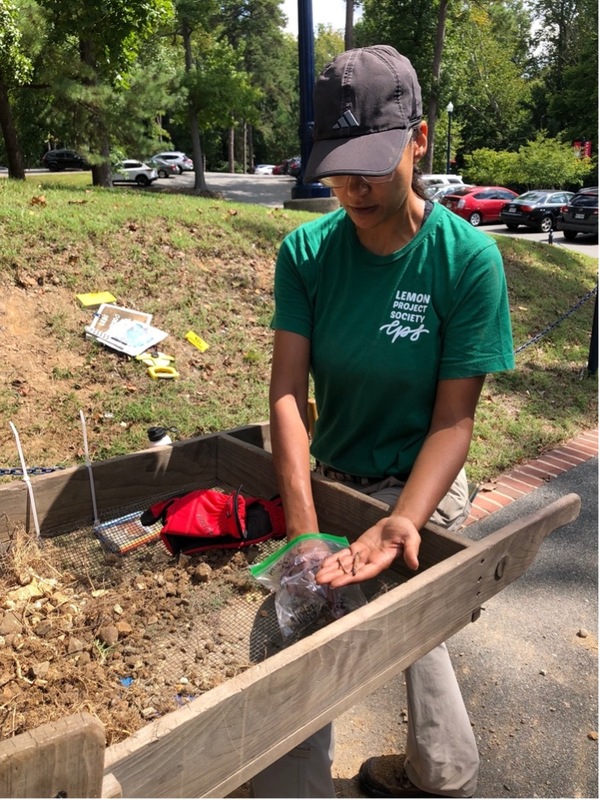Ph.D. Candidate Chardé Reid Awarded a Prestigious Ford Foundation Dissertation Fellowship
Sixth year Ph.D. candidate Chardé Reid was recently awarded a highly prestigious Ford Foundation Dissertation Fellowship which will support her research on the archaeology of Mulberry Island, a 17th-century tobacco plantation site in Tidewater Virginia. Ford Foundation Dissertation Fellowships are awarded to a select number of Ph.D. candidates with outstanding academic credentials and a high potential for transformative research across the arts and sciences. Mulberry Island was a key location during an important formative moment in the history of Virginia and the United States, especially in the development of global capitalism, colonialism, racism and race, and other “modern” values about gender, class, and status. Chardé’s research therefore looks to shed new light on understudied aspects of American and world history. Chardé recently sat down with her friend and fellow cohort member Tomos Evans who interviewed her about her journey as an archaeologist, her doctoral research, and its transformative potential within (historical) archaeology under the Ford Fellowship.

She began by discussing with Tomos what sparked her interest in the past and her global familial connections in Virginia. Chardé comes from a family that had always been interested in the past, and grew up with both sides of her family immersing her in stories of her ancestors, and of the wider histories and folklores of their ancestral homelands locally and globally. Chardé’s mother’s side of the family can trace their ancestry to African and Indigenous communities in Virginia beginning in the early 18th century in Northern Neck, Virginia. On her father’s side, she is descended from Scots Irish who came to Virginia during the early 19th century, and Greek Armenians who migrated to the United States in the 1950s.
“I grew up hearing these amazing stories about family members and ancestors on both sides of my family, from Northern Neck Virginia, Washington DC, Flint Hill Virginia, Armenia, and Thessaloniki and Athens, Greece. Growing up with a global perspective of the past too has always made me more interested in connections between people and how people ended up on their paths and got to the point of the journey that they’re at now. That developed into my academic interests too.” Although Chardé was fascinated by the American history she learned throughout her primary and secondary education, she felt that the top-down national narratives represented in the classroom contrasted significantly from the on-the-ground stories of the past she heard from her family.

In contrast to the nuanced stories told to her by her family, Chardé felt disconnected from the valorized version of American history being taught in the classroom. She initially focused on Greco-Roman archaeology during her undergraduate studies at George Washington University (2006-2009), conducting excavations at the Athenian Agora in Greece, and reading ancient texts such as Herodotus’s Histories and Homer’s Illiad in ancient Greek:
“I did not feel connected to American history for most of my youth and adolescence. I turned to ancient history because of my connection through my grandmother Maria Amadounian Reid.” Her work here under Dr. Rebecca Futo Kennedy on understandings of ethnicity, race, and politics in the ancient world would be an important influence in Chardé’s future doctoral research on early modern Virginia, where translated classical texts on history and philosophy were cherrypicked in the development of the English colonies and their plantation economies.
Following graduation from GW, Chardé would revisit the American past when she was hired as Assistant City Archaeologist at the DC State Historic Preservation Office (SHPO) (2010-2017) under Dr. Ruth Trocolli, the City Archaeologist in DC. Chardé’s work in cultural resource management in DC brought her face-to-face with the diverse past of the nation’s capital. Chardé was fascinated by the incredible diversity that she encountered every day in DC’s archaeological record:
“It opened up a whole new world to me of North American Historical Archaeology. In DC you’re surrounded by all sorts of incredible Black history, as well as various immigrant histories – there are various Chinatowns, “Little Italies,” and “Little Germanies” that the gentrification and Federal development of DC has erased from the modern landscape. But underground we had all these amazing stories we could tell. I began seeing American history in such a different light.”
Chardé’s work in DC would also lead her to engage local communities in her work – something which has been at the forefront of her research and ethos as an archaeologist ever since. She co-field directed several archaeological excavations, including the Yarrow Mamout Archaeology Project alongside Dr. Mia Carey (2015-2017). It was this work that inspired and encouraged Chardé to begin her doctoral studies at William & Mary in 2017, as she describes it:
“Working with communities so closely in that project – communities typically not included in these historical narratives – especially the Black Muslim community, it was such an incredible experience, both as an archaeologist and as a human. It really lit a fire under me to think more critically about ways that I could continue to add to these types of projects, and move archaeology forward into the 21st century.”
What Chardé witnessed throughout her professional on-the-ground archaeological work contrasted dramatically with the more streamlined and exclusionary depictions of American history as represented in American classrooms, museums, and heritage sites. During her doctoral research she has studied and written about the ways in which heritage spaces across the United States have tended to be oriented towards a largely White public. Through her master’s research and publication, Chardé has developed anthropologist Enoch Page’s notion of White Public Spaces in the context of heritage spaces, which have excluded non-white groups and their histories while privileging more narrow, romanticized, and largely self-congratulatory histories of the Euro-American colonial past in America.
Chardé’s critique of these dominant narratives, and the development of her core research themes, has relied on dialogue with local and descendant communities historically excluded from these representations of history. These include descendant communities from Williamsburg who’ve engaged with work at the Angela Site on Jamestown Island – named for one of the first Africans forcibly brought to Virginia in 1619 – as well as the African American Historical Society of Newport News of which Chardé is a board member and co-chair of the Research and History Committee. Both of these groups include people who are lineal and symbolic descendants of First African sites across the Chesapeake and Tidewater regions. Chardé has been engaged in dialogues with these communities since 2018 that have helped orient and center her work, especially around a Black feminist and restorative justice framework.
Chardé’s commitment to researching and representing these marginalized histories using this community-based model, encouraged her to apply for the Ford Foundation Fellowship at a time when efforts to tell these subaltern narratives are coming under attack by right-wing politicians in Virginia and beyond:
“I think that’s really important for the Ford Foundation Fellowship: the focus is diversifying American academia. Through the work that I’m currently doing now with the various community groups that I’m working with but most centrally with the African American Historical Society of Newport News, this theme of education and curriculum, these framings of these historical narratives: who has control of those, who gets to say what those are, is really important. We have an ongoing fight right now in Virginia with the Youngkin administration where they are rolling back some of the gains that we’ve made in Black History and more generally in tying Black History more fully to American History, acknowledging that Black History is American History and American History is Black History.”

Under the Ford Fellowship, she will be completing her doctoral research on the archaeology of the Mulberry Island plantation landscape. Mulberry Island is far less well-known than the nearby site of Jamestown which features prominently in dominant representations of the American past. However, it is similarly significant in Virginia and US history:
“This is the site where some of the earliest English colonial tobacco plantations were located from as early as 1619, and there's documentation that captive Africans were living and laboring on the landscape by 1640.” The 17th-century plantation landscape here was controlled by William Peirce, who would become the father-in-law of John Rolfe, the English merchant and tobacco farmer popularly known for his earlier marriage to the Powhatan woman Pocahontas. Peirce had captive Africans and other indentured laborers working on his tobacco plantations on Jamestown and Mulberry Island, including some of the first Africans in Virginia such as Angela. Archaeological work in the 1980s and 1990s found the remains of a 17th-century domestic site, with evidence of domestic waste and architectural remains. “I am now working through that collection, and primarily focusing on locally produced artefacts, especially artefacts that date to the early period of the colony.” The area also had connections to Indigenous groups in the region with the archaeological record “revealing Native American presence from the pre-contact period all the way through the colonial period”, and the documentary record mentioning that it was attacked by Virginia Indians during the Powhatan Uprising of 1622.
Chardé is exploring some of the transitions of the turbulent 17th century manifest in Mulberry Island’s archaeological record, on a site “where people of different ethnicities, from different regional backgrounds, from different cultures were living together”. The wealthy planter class began to further separate itself from the servant class in the 1640s and 1650s, moving into separate housing which also represented their increased separation “from indentured, enslaved and other unfree categories.” These changes represent some of the beginnings of race and racism in the English colonies, and Chardé is investigating what the transitions in the material and historical records inform us about socioeconomic changes during this period in the Chesapeake.

She is also exploring the role of changing religious and gender ideologies in these processes of racialization, as groups were increasingly separated, stereotyped, and othered according to a range of ideological justifications. An especially interesting aspect of material culture here that Chardé is analyzing are the so-called colonowares, low-fired earthenwares which in the Chesapeake are made from reddish clays and typically tempered with local sand, shell, or gravel. Colonowares were initially interpreted as hybrid artefacts “using Virginia Indian local materials and potting techniques, but often using European vessel forms.” Although, colonoware has increasingly been “distinctively identified with enslaved laborers and the working poor. My research adds to the growing archaeological evidence that colonoware becomes an important marker of an emerging identity of the labor class in the late 17th century.”
Chardé considers colonoware “a multivocal symbol of early America” exemplifying the ways in which “these sites were connected with each other in terms of their materials, and how these people and their materials were moving throughout these sites and the colony.” Chardé’s artefactual analyses throughout her dissertation, and the completion of her Ph.D. under the Ford fellowship, will continue exploring these connections and interactions, at a time when the planter class was increasingly seeking to sever, separate, and segregate emerging racial, gender, and class-based categories.
Chardé is deeply grateful to the Ford Foundation for awarding her this prestigious fellowship, and so thankful to her doctoral committee who have been incredible throughout her Ph.D. in their support and input: Dr. Joseph Jones, Dr. Audrey Horning, Dr. Michael Blakey, and Dr. Adela Amaral. She is also grateful to other members of faculty in Anthropology who have mentored her during her time at William & Mary, including Dr. Michelle Lelievre, Dr. Jonathan Glasser, Dr. Neil Norman, and Dr. Grey Gundaker, as well as faculty from other departments – Dr. Jody Allen, Dr. Elizabeth Losh, Dr. Jajuan Johnson, and Dr. Sarah Thomas. These faculty members, the communities that Chardé has collaborated with from Williamsburg and Newport News, Dr. Christopher McDaid and the Fort Eustis Cultural Resource Management team, as well as all of her friends among the William & Mary graduate community and her Awesome Women Archaeologists Writing Group, have been important to Chardé in her journey as a doctoral student and candidate. As Chardé put it, “it really does take a village to get through graduate school!”














